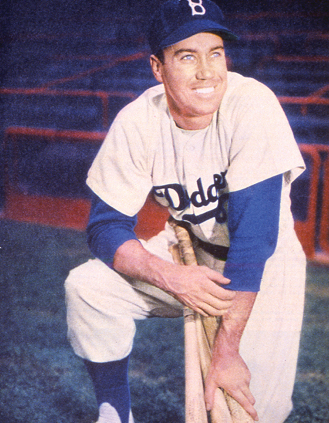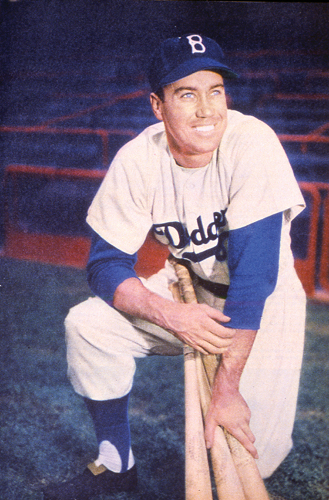June 1, 1955: Duke Snider smashes three homers in anticipated pitchers’ duel
Duke Snider, the Duke of Flatbush, had a phenomenal stretch, blasting at least 40 home runs in five straight seasons (1953-1957) while batting .311 with a .407 on-base percentage and a .618 slugging percentage, yet did not win an MVP award. (Photo: SABR-Rucker Archive)
Sportswriters expected another duel between the starting pitchers, but Duke Snider and his Brooklyn Dodgers teammates changed the script against the visiting Milwaukee Braves. Dem Bums exploded for a team-record six home runs, including three by Snider, who barely missed a fourth one in his last at-bat.
Skipper Walter Alston’s Dodgers were rolling over competition in 1955. They started the season on a 22-2 run, and were in first place with the best record in baseball (32-11), 5½ games in front of the Chicago Cubs. Alston’s team anticipated adding to that lead against an uncharacteristically sputtering fourth-place Braves squad (21-22) during its 16-game homestand. Despite the teams’ seemingly disparate records, the opener of a two-game series was a highly anticipated pitching matchup between right-handers Carl Erskine and Gene Conley. An established star, Erskine possessed a 95-51 career slate (including 6-2, 1.73 ERA thus far in ‘55); had won 20 games in 1953, the same season he set a World Series record with 14 punchouts; and authored a no-hitter in 1952.1 Conley, a 6-foot-8 giant who placed his professional basketball career with the Boston Celtics on hold to pursue baseball, had gone 14-9 in his first full season in 1954 and appeared ready to add his name to the list of best hurlers in baseball with a 7-1 slate in ‘55. The two had engaged in two tense, 12-inning affairs in May, with Erskine tossing a six-hit, 2-0 shutout in the first and Conley emerging victorious, 2-1, on a six-hitter in the second. Sportswriter Dick Young compared the performances to the legendary battles between the Dodgers’ Whit Wyatt and the Cardinals’ Mort Cooper in late 1941 and 1942.2
On a crisp, 60-degree Wednesday evening, 18,380 spectators came to Ebbets Field, 5,000 more than the team’s eventual season average and more than three times than the 6,008 of a day earlier, a lackluster 6-3 loss to the lowly Pittsburgh Pirates.3
It didn’t take long for the game to transform into a “shoot-’em-up,” noted Young.4 Erskine looked wobbly from the beginning against the Braves’ formidable lineup, which was without its most dangerous threat, Eddie Mathews, sidelined with appendicitis.5 After retiring leadoff man Bill Bruton, Erskine walked Chuck Tanner, and Hank Aaron singled. Big George Crowe smacked a liner to center, driving in Tanner, but Aaron was out on third baseman Danny O’Connell’s relay throw home. The potent Dodgers’ offense, which easily led the majors with 201 home runs and 857 runs scored in 1955, quickly reclaimed the lead. With one out in the bottom of the first, slumping Pee Wee Reese, just 8-for-42 in his last 11 games, knocked one over the left-field wall. Snider followed with a blast into the lower center-field stands to make it 2-1, Dodgers.6
By the beginning of the second inning, both managers had their bullpens working. It looked as if Erskine might not make it through the frame when Bobby Thomson led off with a triple off the center-field wall7 and tied the game on O’Connell’s groundout. Del Crandall doubled and gave the Braves the lead, 3-2, two batters later, scoring on Bruton’s single.
Both pitchers regained their composure, retiring a combined 14 of 15 batters, until two out in the bottom of the fourth. Carl Furillo walked and Jackie Robinson, who had doubled and was erased in a twin killing in his last at-bat, smashed his fourth home run of the season to give the Dodgers the lead for good. “Don [Newcombe] watched Conley warm up before the game,” said Robinson, “and noticed that he wasn’t masking his curve ball. We knew every pitch he was throwing.”8 After Jim Gilliam walked and Erskine singled over the mound, Reese’s single made it 5-3 and sent Big Gene to the showers.
Braves skipper Charlie Grimm played the percentages by calling on rookie southpaw Roberto Vargas to face the left-hand-hitting Snider. It seemed like a good decision. The Duke of Flatbush feasted on right-handers throughout his career, but saw his power numbers fall precipitously against southpaws. In 1954, when Snider lost the batting title on the last day of the season to Willie Mays, his slugging percentage dropped almost 200 points (.669 to .477) against lefties, though he still hit. 308 against them. He greeted Vargas with a towering shot that sailed “far over the right field screen,” wrote Young, for an 8-3 Dodgers lead. Vargas loaded the bases on walks to Roy Campanella and Gil Hodges sandwiched around a single to Sandy Amoros. He was replaced by Ernie Johnson, who retired Furillo to keep the Braves in the game.
With the Dodgers still leading 8-3, Reese walked to lead off the bottom of the sixth. Snider hit a towering shot over the right-field wall and onto Bedford Avenue, reported the New York Times.9 The Duke’s third home run and sixth RBI of the game gave him the NL lead in both categories (15/48).
The Dodgers’ seven-run lead quickly evaporated in the seventh when Erskine unraveled. He loaded the bases on walks to pinch-hitter Joe Adcock and Tanner and a single by Bruton. Reese flubbed a possible double-play grounder by Aaron, leading to the Braves’ first run of the frame. After Crowe fanned, Johnny Logan cleared the bases by tripling into the center-field corner niche.10 Rubber-armed Jim Hughes, who had led the majors with 60 appearances in 1954, took over for Erskine. Thomson’s deep fly plated Logan to cut the Dodgers’ lead to 10-8.
With the Dodgers still clinging to a two-run lead in the bottom of the eighth, Snider came to bat with one out against left-hander Chet Nichols, the Braves’ fifth pitcher of the day, with a chance to make history with his fourth home run. A year earlier, on July 31, 1954, at Ebbets Field, Joe Adcock became the seventh player in NL/AL history to hit four home runs in a game, and narrowly missed another when his deep fly caromed off the left-field wall in the third.
In an electric atmosphere, the Ebbets Field crowd cheered for the Duke while organist Gladys Gooding played the 1920s Al Jolson Broadway hit “California, Here I Come.” At the height of his popularity, Snider was in the third year of an impressive five-year run (1953-1957) during which he clouted at least 40 home runs every season, averaged 41 homers and 117 RBIs per season, and slashed .311/.407/.618 as one of baseball’s most dangerous sluggers. Nonetheless, he never won an MVP Award in that stretch, though he finished as high as second in 1955. However, his teammates Robinson (1949), Campanella (1951, 1953, 1955), and Newcombe (1956) won trophies.
The situation might have conjured up feeling of déjà vu for Snider. In the second game of a twin bill on May 30, 1950, against the Philadelphia Phillies at Ebbets Field, Snider blasted home runs in his first three plate appearances. In his fourth and final at-bat, leading off the seventh, he barely missed his fourth, when his powerful shot “nearly tore the top hamper off the right-field screen,” wrote Dodgers beat reporter Harold C. Burr.11
Facing an infield shift with the third baseman in the grass in shallow right field,12 Snider launched a shot to deep right field. “For a minute I thought I had the fourth one,” he said after the game. Snider. “I hit it real good but it sort of sunk on me and hit the screen.”13 The Associated Press’s Joe Reichler lamented that “two yards of chicken wire” robbed Snider of history, as the ball caromed off the screen for a double.14 Moments later, Snider was caught stealing. Campanella, who had entered the game leading the NL in home runs (13) and RBIs (46) before giving way to Snider, sent one into the stands in deep center field to set a new Dodgers team record with six home runs in a game.
Hughes worked a scoreless ninth, working around a two-out double by Logan and ending the game in 2 hours and 46 minutes when Thomson flied out.
The Duke was the story in the Dodgers’ 11-8 slugfest victory. He went 4-for-5, hit three home runs for the second time, and set a career best with six RBIs.
Epilogue: Both starting pitchers struggled physically as the season wore on. Erskine tossed a four-hit shutout two starts later, but posted an ERA approaching 6.00 for the remainder of the season to finish with 3.79 ERA and an 11-8 record, plagued by shoulder pain. Conley suffered a torn rotator cuff that derailed his promising career. He pitched only once in ‘55 after July 22 and ended with an 11-7 record and a 4.16 ERA. Snider finished with 42 home runs, and led the majors with 126 runs and 136 RBIs; however, Campanella won his third MVP in five seasons, slashing 32/107/.318. Dem Bums captured their fifth pennant since Jackie Robinson debuted in 1947. Facing the Yankees in each of those series, the Dodgers finally emerged victorious, capturing their first and only title in Brooklyn, in seven games. Snider was one of the heroes, blasting four home runs and driving in seven runs, while 22-year-old Johnny Podres pitched a 2-0 shutout in the clinching game.
SOURCES
In addition to the sources cited in the Notes, the author accessed Retrosheet.org, Baseball-Reference.com, and SABR.org.
NOTES
1 Erskine’s 1952 no-hitter was a 5-0 whitewashing of the Chicago Cubs. He pitched a second no-hitter in 1955 against the New York Giants.
2 Dick Young, “Erskine, Conley Resume Duel at Dusk in B’klyn,” New York Daily News, June 2, 1955: 92.
3 “Daily Almanac, New York Daily News, June 2, 1955: 92: 2.
4 Dick Young, “Flock Sprays Braves, 11-8, with 6 HRs (3 by Duke),” New York Daily News, June 2, 1955: 78.
5 Associated Press, “Grimm Shrugs Off Reports His Milwaukee Days Are Numbered,” Elmira (New York) Star-Gazette, June 2, 1955: 39.
6 Roscoe McGowen, “Dodgers Defeat Braves; Six Brook Homers Decide Game, 11-8,” New York Times, June 2, 1955: 36.
7 McGowen.
8 Fred Down (United Press), “Snider’s 3 Homers Defeat Braves, 10-8,” News-Record (Neenah, Wisconsin), June 2, 1955: 4.
9 McGowen.
10 McGowen.
11 Harold C. Burr, “Dodgers Find Cards Alive and Slugging,” Brooklyn Eagle, June 1, 1950: 21.
12 United Press, Snider Gives Up Sure Single to Try for Homer Record. Who Wouldn’t?” News-Record (Neenah, Wisconsin), June 2, 1955: 4.
13 Joe Reichler (Associated Press), “Snider Just Missed 4-HR Bid,” Elmira Star-Gazette, June 2, 1955: 38.
14 Reichler.
Additional Stats
Brooklyn Dodgers 11
Milwaukee Braves 8
Ebbets Field
Brooklyn, NY
Box Score + PBP:
Corrections? Additions?
If you can help us improve this game story, contact us.



